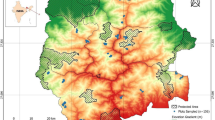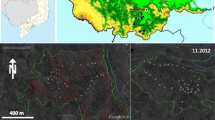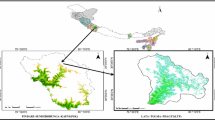Abstract
A total of 141 quadrats were sampled using stratified random sampling to study forest, environment and human interactions along an elevation gradient 1800 to 3665 m at the remote Kailash Sacred Landscape, Nepal. Eight forest types were identified, including Laurel-Oak to Rhododendron to Blue pine, comprising 191 species including 60 useful from 166 genera and 87 families. The environmental variables elevation, slope, and temperature were significant (p < 0.001) in determining the composition and distribution of forest types. Records of large numbers of useful plants along with diverse forest and vegetation types suggest a strong association between the culture of local villages and nature conservation. Due to changes in climate, socio-culture and land-use, forest degradation is expected to accelerate, thus forcing government and indigenous community forest management measures to acknowledge human, cultural and environmental variables for sustainable forest management.




Similar content being viewed by others
References
Aigbokhan EI, Agianaku OF (2015) Composition, structure and conservation potential of vegetation adjoining a wire-mesh perimeter fence at the University of Benin farmsite, Benin city, Nigeria. Niger J Weed Sci 28:1–39
Alexander R, Millington A (2000) Vegetation mapping: from patch to planet. Wiley, Chichester, p 350
Anderson AB, Posey DA (1989) Management of a tropical scrub savanna by the Gorotire Kayapó of Brazil. Adv Econ Bot 7:159–173
Anderson D, Salick J, Moseley RK, Xiaokun O (2005) Conserving the sacred medicine mountains: a vegetation analysis of Tibetan sacred sites in Northwest Yunnan. Biodivers Conserv 14:3065–3091
Atreya K, Pyakurel D, Thagunna KS, Bhatta L, Uprety Y, Chaudhary R, Oli BN, Rimal S (2018) Factors contributing to the decline of traditional practices in communities from the Gwallek-Kedar area, Baitadi, Kailash Sacred Landscape, Nepal. Environ Manag 61:741–755
Bajracharya D (1983) Fuel, food of forest: dillemas in Nepali village. World Dev 2:1057–1074
Bhatta DB (2003) Community approaches to natural resources management: sacred and non-sacred landscapes in Nepal. Master thesis, Miami University, Ohio, p 50
Bhattarai KR, Vetaas OR, Grytnes JA (2004) Relationship between plant species richness and biomass in arid sub-alpine grassland of the central Himalayas, Nepal. Folia Geobot 39:57–71
Bista S, Webb EL (2006) Collection and marketing of non-timber forest products in far western hills of Nepal. Environ Conserv 33:244–255
Chand PB, Wilson A (1987) A case study of the development of local forest management in Darchula. Banko Janakari 1(4):20–23
Chaturvedi OP, Singh JS (1986) The structure and function of pine forest in central Himalaya. I: dry matter dynamics. Ann Bot 60:237–252
Chaudhary RP, Shrestha KK, Jha PK, Bhatta K (2010) Kailash Sacred Landscape conservation initiative feasibility assessment report—Nepal. International Center for Integrated Mountain Development, Kathmandu, p 207
Chawla A, Rajkumar S, Singh K, Lal B, Singh R, Thukral A (2008) Plant species diversity along an altitudinal gradient of Bhabha Valley in western Himalaya. J Mt Sci 5:157–177
Chhetri R, Pandey TR (1992) Use group forestry in Far Western Region of Nepal: case studies from Baitadi and Accham. International Center for Integrated Mountain Development, Kathmandu, p 101
Corvinus G (2004) Homo erectus in East and Southeast Asia, and the questions of the age of the species and its association with stone artifacts, with special attention to hand axe-like tool. Quatern Int 117:141–151
de Klemn C (1985) Culture and conservation: some thought for the future. In: McNeely JA, Peet D (eds) Culture and conservation: the human dimension of environmental planning. Croom Helm, London, UK, pp 239–257
Devkota R, Karmacharya SB (2003) Documentation in indigenous knowledge of medicinal plants in Gwallek VDC, Baitadi, Nepal. Bot Orient 3:135–143
DFO (2017) Sigas protected forest, Sigas, Baitadi. District Forest office, Baitadi, p 25
DoF (2017) Community forest database of Nepal. Community Forest Division, Department of Forest, Kathmandu
Elliott A (2012) Botanical exploration of Darchula district, Farwest Nepal. Scottish Rock Garden Club, Royal Botanic Garden Edinburgh, The University of Edinburgh, Edinburgh, p 35
Eriksson M, Xu J, Shrestha AB, Vaidya RA, Nepal S, Sandström K (2009) The changing Himalayas: impact of climate change on water resources and livelihoods in the Greater Himalayas. Kathmandu: ICIMOD, p 23
Fisher RJ (1991) Studying indigenous forest management system in Nepal: toward a more systematic approach. EAI East West Center, Hawaii, p 30
Fortier J (2009) Kings of the forest: the cultural resilience of Himalayan hunter-gatherers. University of Hawaii Press, Honolulu, p 232
Gandiwa E (2014) Vegetation factors influencing density and distribution of wild large herbivores in a southern African savannah. Afr J Ecol 52(3):274–283
Garbyal SS, Aggrawal KK, Babu CR (2005) Traditionally used medicinal plants in Dharchula Himalayas of Pithoragarh. Indian J Tradit Knowl 4:199–207
Gehrke B, Linder HP (2014) Species richness, endemism and species composition in the tropical Afroalpine flora. Alp Bot 24(2):165–177
GoN (2010) Feasibility assessment report for Api-Nampa Conservation Area, Darchula. Department of National Parks and Wildlife Conservation. Kathmandu, Nepal (report number, pages)
GoN (2014) Api Nampa Management plan 2014–2019. Department of National Parks and Wildlife Conservation, Kathmandu, p 104
Heim A, Gansser A (1939) The throne of the gods. The McMillan Co, York, p 233
Hill I (1999) Forest management in Nepal: economics and ecology. World Bank Publication WTP445, Washington, p 68
Holland PG, Steyne DG (1975) Vegetation responses to latitudinal variations in slope angle and aspect. J Biogeogr 2:179–183. https://doi.org/10.2307/3037989
Khumbongmayum AD, Khan ML, Tripathi RS (2005) Ethnomedicinal plants in the sacred grooves of Manipur. Indian J Tradit Knowl 4:21–32
Korner C (2007) The use of altitude in ecological research. Trends Ecol Evol 22:569–574
Kunwar RM, Sharma S (2004) Quantitative analysis of tree species in two community forests of Dolpa district, mid-west Nepal. Himal J Sci 2(3):23–28
Kunwar RM, Baral K, Paudel P, Acharya RP, Thapa-Magar KB, Cameron M, Bussmann RW (2016) Land-use and socioeconomic change, medicinal plant selection and biodiversity resilience in Far Western Nepal. PLoS ONE 11(12):e0167812. https://doi.org/10.1371/journal.pone.0167812
Kunwar RM, Fadiman M, Cameron M, Bussmann R, Thapa-Magar K, Rimal B, Sapkota P (2018) Cross-cultural comparison of plant use knowledge in Baitadi and Darchula districts, Nepal Himalaya. J Ethnobiol Ethnomed 14:40
Lilleso JB, Shrestha TB, Dhakal LP, Nayaju RP, Shrestha R (2005) The map of potential vegetation of Nepal: a forestry/agroecological/biodiversity classification system. For Landsc Dev Environ CFC-TIS Doc Ser 2:110
Loffler J, Pape R (2008) Diversity patterns in relation to the environment in Alpine Tundra ecosystems of the Northern Norway. Arct Antarct Alp Res 40:373–381
MacArthur RH, Wilson EO (1967) Theory of island biogeography. Princeton University Press, Princeton, p 244
Mani MS (1978) Ecology and phytogeography of the high altitude plants of the Northwest Himalaya. Oxford & IBH Publishing Company, New Delhi, p 205
Manzardo AE (1977) Ecological constraints on trans-Himalayan trade in Nepal. Contrib Nepal Stud 4:63–81
McVicar TR, Körner C (2012) On the use of elevation, altitude, and height in the ecological and climatological literature. Oecologia 171:335–337
Messerli B, Ives JD (1997) Mountains of the world: a global priority. Parthenon Publishing Group, New York, p 495
Metz JJ (1997) Vegetation dynamics of several little disturbed temperate forests in east central Nepal. Mt Res Dev 17:333–351
Miehe G, Miehe S, Schlutz F (2009) Early human impact in the forest ecotone of southern High Asia. Quatern Res 71:255–265
Miehe G, Miehe S, Böhner J, Bäumler R, Ghimire SK, Bhattarai K, Chaudhary RP, Subedi M, Jha PK, Pendry C (2015) Vegetation Ecology. In: Miehe G, Pendry C, Chaudhary RP (eds) Nepal: an introduction to the natural history, ecology and human environment of the Himalayas. Royal Botanical Garden, Edinburgh, pp 385–472
Moerman DE (1979) Symbols and selectivity: a statistical analysis of Native American medical ethnobotany. J Ethnopharmacol 1:111–119
Mueller-Dombois D, Ellenberg H (1974) Aims and methods of vegetation ecology. Wiley, New York, p 547
Munthe J, Dongol B, Hutchison JH, Kean WF, Munthe K, West RM (1983) New fossil discoveries from the Miocene of Nepal include a Hominoid. Nature 303(5915):331–333
Negi VS, Pathak R, Sekar KC, Rawal RS, Bhatta ID, Nandi SK, Dhyani PP (2017) Traditional knowledge and biodiversity conservation: a case study from Byans valley in Kailash Sacred Landscape, India. J Environ Plan Manag. https://doi.org/10.1080/09640568.2017.1371006
Nepal M, Das S, Rai R, Bhatta L, Somanathan E, Kotru R, Kadayat M, Rawal R, Negi GS (2017) Valuation of ecosystem services in the Kailash Sacred Landscape. ICIMOD 17(2):86
Pandey S, Maraseni TN, Cockfield G (2014) Dynamics of carbon and biodiversity under REDD + regime: a case from Nepal. Environ Sci Policy 38:272–281
Pant SD (1935) The social economy of the Himalaya. George Allen and Unwin, London, p 264
Paradis E, Claude J, Strimmer K (2004) APE: analyses of phylogenetics and evolution in R language. Bioinformatics 20:289–290
Pielou EC (1975) Ecological diversity. Wiley, London
Pradhan K (1998) Origin of Ramapithecus in Nepal. Anc Nepal 107:15–29
Salick J, Biun A, Martin G, Apin L, Beaman R (1999) Whence useful plants? A direct relationship between biodiversity and useful plants among the Dusun of Mt. Kinabalu. Biodivers Conser 8:797–818. https://doi.org/10.1023/A:1008853413930
Salick J, Ghimire SK, Zhendong F, Dema S, Konchar KK (2014) Himalayan alpine vegetation, climate change and mitigation. J Ethnobiol 34(3):276–293
Shah S, Tewari A, Tewari B (2009) Impact of human disturbance on forest vegetation and water resources of Nainital catchment. Nat Sci 7:7478
Shaheen H, Ullah Z, Khan SM, Harper DM (2012) Species composition and community structure of western Himalayan moist temperate forests in Kashmir. For Ecol Manag 278:138–145
Shannon CE, Wiener W (1949) The mathematical theory of communication: unknown distance Function. Illinois Press, Urbana, pp 1–117
Singh H, Kumar M, Sheikh MA (2009) Distribution pattern of Oak and Pine along altitudinal gradients in Garhwal Himalaya. Nat Sci 7:81–85
R Development Core Team (2017) R: a language abd environment for statistical computing. R Foundation for Statistical Computing, Vienna, Austria. http://www.R-project.org/
ter Braak CJF, Smilauer P (2002) CANOCO reference manual and CanoDraw for Windows user’s guide: software for canonical community ordination (version 4.5)
ter Steege H, Pitman N, Sabatier D, Castellanos H, Van Derhout P, Daly DC, Silveira M, Phillips O, Vasquez R, van Andel T, Duivenvoorden J, Adalardo De Oliveira A, Ek R, Lilwah R, Thomas R, Van Essen J, Baider C, Maas P, Mori S, Terborgh J, Núñez Vargas P, Mogollon H, Morawetz W (2003) A spatial model of tree α-diversity and tree density for the Amazon. Biodivers Conserv 12:2255–2277
Timilsina N, Ross MS, Heinen JT (2007) A community analysis of Sal (Shorea robusta) forests in the western Tarai of Nepal. For Ecol Manag 241:223–234
Uddin K, Chaudhary S, Chettri N, Kotru R, Murthy M, Chaudhary RP, Ning W, Shrestha SM, Gautam SK (2015) The changing land cover and fragmenting forest on the Roof of the World: a case study in Nepal’s Kailash Sacred Landscape. Landsc Urban Plan 141:1–10
Valida KS (1998) Dynamic Himalaya. University Press Ltd., Haidarabad, p 178
van Andel T (2000) Non-timber forest products of the North-West District of Guyana: Part I. Tropenbos-Guyana Series 8B. Print Partners Ipskamp B.V., Amsterdam, p 325
Vittoz P, Bayfield N, Brooker R, Elston DA, Duff EI, Theurillat JP, Guisan A (2010) Reproducibility of species lists, visual cover estimates and frequency methods for recording high-mountain vegetation. J Veg Sci 21:1035–1047
Zhang JT, Ru WM (2010) Population characteristics of endangered species Taxus chinensis var. mairei and its conservation strategy in Shanxi, China. Popul Ecol 52:407–416
Zhang JT, Xu B, Li M (2013) Vegetation patterns and species diversity along elevational and disturbance gradients in the Baihua Mountain Reserve, Beijing, China. Mt Res Dev 33:170–178
Zomer RJ, Oli KP (2011). Kailash sacred landscape conservation initiative: feasibility assessment report. Kathmandu: ICIMOD, p 92, ISBN: 978 92 9115 211 7
Zomer RJ, Trabucco A, Metzger M, Oli KP (2013) Environmental stratification of Kailash Sacred Landscape and projected climate change impacts on ecosystems and productivity. Kathmandu: ICIMOD 13(1):1–25
Acknowledgements
Author Ripu M Kunwar is thankful to the Rufford Foundation, UK (Grant # 21198-2, 25296-B) and FAU Dissertation Year Support Grant 2018 (GT-001801) for providing support for fieldwork. The authors are grateful to the communities who participated in the fieldwork and dedicated their invaluable time. Laxmi Mahat, Shiv Bhatta, Prem Bhat, Hira Dhami, Prabhat Sapkota and Sanjay Tiwari are recognized for their assistance in field work, and Arjun Adhikari, Shishir Paudel, Keshav Bhattarai, Tulasi Acharya, Chris LeBoa, Bhagawat Rimal and Robbie Hart for helping with data analysis, editing drafts and making graphs. The authors express thanks to anonymous reviewers for their critical remarks on earlier versions of this paper.
Author information
Authors and Affiliations
Corresponding author
Additional information
Publisher's Note
Springer Nature remains neutral with regard to jurisdictional claims in published maps and institutional affiliations.
Project funding: The project was partially funded by Rufford Foundation, UK (Grant # 21198-2, 25296-B) and Florida Atlantic University, USA (GT-001801).
The online version is available at https://www.springerlink.com.
Corresponding editor: Zhu Hong.
Electronic supplementary material
Below is the link to the electronic supplementary material.
Rights and permissions
About this article
Cite this article
Kunwar, R.M., Fadiman, M., Hindle, T. et al. Composition of forests and vegetation in the Kailash Sacred Landscape, Nepal. J. For. Res. 31, 1625–1635 (2020). https://doi.org/10.1007/s11676-019-00987-w
Received:
Accepted:
Published:
Issue Date:
DOI: https://doi.org/10.1007/s11676-019-00987-w




